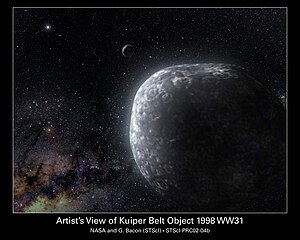1998 WW31

Artist's Impression of 1998 WW31 and its satellite
|
|
| Discovery | |
|---|---|
| Discovered by | Deep Ecliptic Survey |
| Discovery date | 18 November 1998 |
| Designations | |
| MPC designation | 1998 WW31 |
| none | |
| Trans-Neptunian object | |
| Orbital characteristics | |
| Epoch 13 January 2016 (JD 2457400.5) | |
| Uncertainty parameter 4 | |
| Observation arc | 4784 days (13.10 yr) |
| Aphelion | 48.432 AU (7.2453 Tm) |
| Perihelion | 40.847 AU (6.1106 Tm) |
| 44.640 AU (6.6780 Tm) | |
| Eccentricity | 0.084953 |
| 298.26 yr (108938 d) | |
|
Average orbital speed
|
4.46 km/s |
| 137.944° | |
| 0° 0m 11.897s /day | |
| Inclination | 6.8069° |
| 237.116° | |
| 50.406° | |
| Known satellites | 1 |
| Earth MOID | 39.8336 AU (5.95902 Tm) |
| Jupiter MOID | 35.6694 AU (5.33607 Tm) |
| Physical characteristics | |
| Dimensions | 133±15 km |
| Mass | 1.3–2.5×1018 kg (system) |
|
Mean density
|
1.5 g/cm³ (assumed) |
|
Equatorial surface gravity
|
0.025–0.031 m/s² |
|
Equatorial escape velocity
|
0.054–0.068 km/s |
|
Sidereal rotation period
|
570 d (system orbital period) |
| 0.05–0.09 (assumed) | |
| Temperature | ~42 K |
| 6.7 | |
1998 WW31 (also written 1998 WW31) is a double Kuiper belt object. It was discovered in 1998 by the Deep Ecliptic Survey (DES).
1998 WW31 forms a binary system with another object with the IAU provisional designation S/2000 (1998 WW31) 1: the first trans-Neptunian binary to be discovered since Pluto, and one of the most symmetrical binaries known in the Solar System. The two bodies are very close in size, with a diameter ratio of 1.2 and a mass ratio of 1.74, assuming similar surfaces and densities. Their orbital period is approximately 570 days, and they orbit at a distance of approximately 4000 km (closest approach) to 40,000 km, with a semi-major axis of about 22,000 km. Their diameters are likely to be in the 100–150 km range, assuming a density of 1–2 g/cm³. Their combined mass is 1/6000th that of the Pluto–Charon system.
...
Wikipedia
